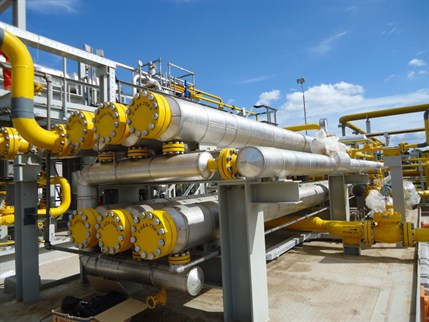Honeywell UOP technology uses wellhead gas to fuel on-site equipment

Photo courtesy of Honeywell UOP.
Honeywell UOP’s modular natural gas processing equipment enables Virginia Indonesia Co. (VICO) to use natural gas straight from the wellhead to power on-site equipment.
Raw natural gas is often corrosive, or “sour,” making it unsuitable for fueling on-site power-generation machinery without damaging the equipment. The modular fuel gas conditioning system uses Honeywell UOP’s Separex technology to remove corrosive contaminants from natural gas streams, allowing it to safely and reliably fuel on-site machinery.
“Honeywell UOP’s modular Separex technology is factory-built, easily shipped to the project site and ideally suited for operation in remote locations,” said John Gugel, vice president and general manager for Honeywell UOP’s Gas Processing and Hydrogen business. “The value of this solution is that you can use the very fuel you’re producing to run the on-site equipment, rather than another fuel such as diesel that continually has to be transported to the site and is subject to supply interruptions.”
Because it is built in a factory, the system starts up faster and operates more reliably than systems constructed on site, enabling customers to begin earning revenue faster. The standardized modular system is designed to easily fit together with other equipment and is easier to operate due to common parts and standardized training, operations and maintenance.
Demand for natural gas is rising in Indonesia and many other developing countries along with economic growth, even as domestic sources of crude oil decline by about 4% annually. The government of Indonesia is making infrastructure investments to promote the use of natural gas as a transportation and household fuel, a feedstock for fertilizers, and for generating electricity.
The Indonesia natural gas program includes the development of new domestic sources to forestall importation, which could become necessary as early as 2019, according to the nation’s Ministry of Energy and Mineral Resources. Indonesia currently has proven reserves of 98 Tcf of natural gas, with as many as 53 Tcf yet to be developed, according to the Ministry.
Rapid commercialization of new gas reserves in Indonesia will require substantial investment as part of a $24 B national energy modernization program that will bring natural gas from distant locations to population centers in Java and Sumatra. Modular equipment from Honeywell UOP is critical to powering and processing natural gas at wells in these remote areas.
Honeywell UOP Separex membrane systems contain spiral wound membrane elements that remove acid gas and water from natural gas streams. Decades of operation in natural gas service demonstrate that Separex membranes are the most durable type of membrane in the industry. To date, more than 130 Separex systems have been installed worldwide.
“This application of the technology is in a remote location in Indonesia, proving that it can be a viable solution just about anywhere in the world where sour gas is available to run equipment,” Gugel said. “Modular units such as this are built to very high standards in a controlled environment and can even be redeployed to other locations if necessary.”
VICO has operated the Sanga-Sanga Production Sharing Contract (PSC), located in the Kutai Basin of East Kalimantan, for more than 40 years. It has produced more than 12.6 Tcf of gas and 400 MMbbl of liquid from the production fields in Badak, Mutiara, Semberah, Nilam, Pamaguan, Lampake, and Beras.

- ExxonMobil halts 1-Bft3d blue hydrogen project in Texas
- Aramco and Yokogawa commission multiple autonomous control AI agents at Fadhili gas plant
- Ukraine will resume gas imports via Transbalkan route in November
- Mitsubishi to inject $260 MM into Brunei LNG project
- Freeport LNG (U.S.) on track to take in more natgas on Thursday after unit outage



Comments